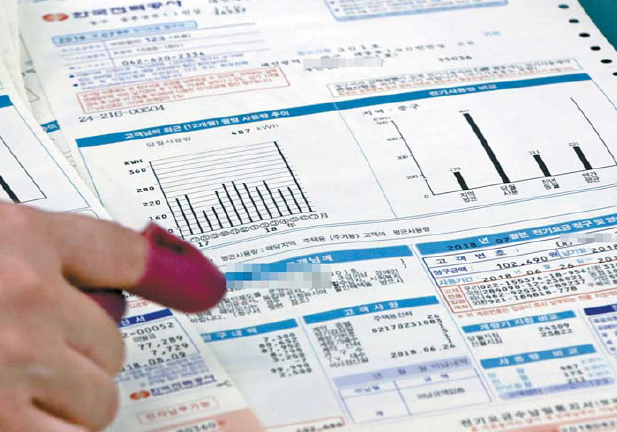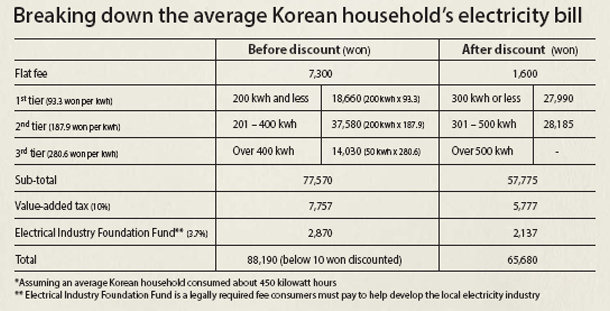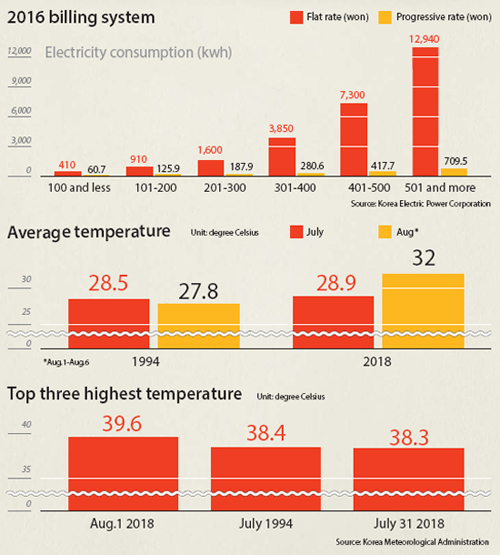[Debriefing] Electricity pricing

Stacks of July electricity bills, ready to be delivered, receive final touches at the Korea Electric Power Corporation’s office in Daejeon on Monday. [YONHAP]
Scared about the July electricity bills set to arrive on their doorsteps, Koreans urged that the government slash utility costs, at least temporarily. President Moon Jae-in answered the public’s pleas and ordered the Ministry of Trade, Industry and Energy to come up with a plan to lower power costs.
Here are the basics on how Korea’s electricity billing system works and how the government is helping out with the bills this summer.
Q. How does the electricity pricing system charge users?
Korea Electric Power Corporation (Kepco), a state-run utility firm under the Energy Ministry, is responsible for distributing electricity and sending bills to households.
Kepco charges users based on three categories. The rate charged for electricity increases progressively based on the amount used.
If you use less than 200 kilowatt hours of electricity in a month, the rate is 93.3 won ($0.08) for every kilowatt hour. But when you consume between 200 and 400 kilowatt hours, the rate goes up to 187.9 won, which is double the first category rate, for the amount of power used over 200 kilowatt hours. For the amount used over 400 kilowatts an hour, the charge is 280.6 won, which is triple the rate in the first category.
For users who exceed 1,000 kilowatt hours a month, 709.5 won is charged for every kilowatt hour used over that limit.
An additional flat fee is also added to bills based on the usage bracket households fall into.
Those who have used 200 kilowatt hours or less are charged a flat fee of 910 won. Households that have used between 201 and 400 kilowatts have to pay 1,600 won, and those that have used more than 400 kilowatt hours are charged 7,300 won.

The government is pushing up the ceiling for the first two pricing tiers for July and August by 100 kilowatt hours.
This means users will pay 93.3 won for every kilowatt hour they consume up to 300 kilowatt hours, instead of the previous 200. For the middle pricing tier, households will also be charged 187.9 won per kilowatt hour up to 500 kilowatt hours instead of 400.
According to Paik Un-gyu, the energy minister, average Korean households will get a discount of 19.5 percent on their bills in July and August. In total, the government will end up cutting the cost of electricity for the two months by as much as 276.1 billion won.
Although this is good news for average Koreans, Kepco will end up paying the price. It’s likely that the power company will have to cover the costs, at least for the time being, until the Energy Ministry compensates the company.
Q. Has it ever offered discounts on summer electricity bills before?
The government offered similar temporary discounts back in 2015 and 2016.
Back then, the pricing system had six incremental rates rather than three. This system was overhauled in the winter of 2016.
The government gave an additional 30 percent discount of up to 16,000 won to households living on government support, those with multiple children and people with disabilities that year.
In 2015, the Park Geun-hye administration provided discounts from July to September by adjusting the rates applied to each stage. For instance, the rate charged for the second stage was used as the rate for the third stage, and the rate charged for the third stage was used as the rate for the fourth stage.
In 2016, the government used one similar to the method the Moon government decided to adopt. But unlike this time, consumers were given discounts for three months from July to September, just like in 2015.
Q. What bracket would an average household fall into?
The average urban four-member household in Korea would fall into the second pricing tier. According to the Energy Ministry, about 15.12 million households fall into this category, accounting for 65 percent of Korea’s population.
The government estimated the average July energy consumption at 450 kilowatt hours, which would cost 88,190 won. But thanks to the government’s discounts, households will see their bills reduced by 25.5 percent, or 22,510 won, to 65,680 won.
Some Koreans are unsatisfied with the discounts offered.
They argue that most households will actually receive a reduction of only about 10,000 won on their bills, which they say is not enough.
Many are calling on the government to get to the bottom of the issue and completely overhaul the current electric pricing system, not just offer discounts for July and August.

This summer heat this year has been the worst since temperatures started being recorded in Korea 111 years ago. According to the Korea Metrological Administration, Seoul’s temperature on Aug. 1 rose to 39.6 degrees Celsius (103.2 degrees Fahrenheit), a new record high, breaking the previous record of 38.4 degrees Celsius, which was recorded on July 24, 1994. The heat wasn’t only unbearable during the day. For the 17 days leading up to Aug. 6, the temperature between 6 p.m. and 9 a.m. never dipped below 25 degrees Celsius. Because of the heat wave, people resorted to air conditioning at night, leading to fears of massive electricity bills.
The main reason some people want to completely overhaul the billing system is because it’s likely that this year’s sweltering summer will not be a one-off. Korea’s summers will likely become longer and hotter due to global warming.
The government estimated that when the same urban family of four runs their air conditioner for more than 10 hours a day, their power usage would hit 904 kilowatt hours for the month. If so, their household electricity bills would quadruple to 232,055 won, a huge financial burden, especially for low-income families.
Others argue that Kepco was charging average households too much compared to the rates charged to companies.
According to the energy consultant company Enerdata, Korea has the world’s seventh-largest electricity demand, consuming a total of 534 terawatt hours last year. Korea’s is also the second-fastest growing country after Turkey in terms of electricity consumption. This is largely due to the huge amount of electricity used for industrial purposes.
Kepco estimates that, since 2015, industrial electricity consumption accounted for 56.6 percent of total use while households only used 13.6 percent. The rest was electricity used for commercial purposes, such as at restaurants and commercial buildings.
Industrial electricity prices change according to the season - summer, spring, fall and winter all have their own rates. The same system applies to commercial power supplies.
In 2016, some argued in favor of getting rid of the progressive rate system, but Kepco strongly opposed this on the grounds that the progressive electricity rate prevents consumers from using excessive electricity.
Q. What did the government do to change the system back in 2016?
The biggest change the government made was simplifying the billing tiers by reducing the six categories into three in November 2016. The new system charged a maximum rate of 709.5 won per kilowatt hour for those who use more than 1,000 kilowatt hours of energy a month.
It was the first change to the electricity billing system in 12 years.
The progressive electricity billing system was adopted in late 1974 in an effort to control the use of electricity, as at that time Korea’s electricity supplies were insufficient and unstable. It is a system designed to ward off excessive energy use by increasing the financial burden households face. But due to economic reasons, this billing system was not adopted for industrial and commercial purposes.
Originally, the progressive electricity billing system had three stages. In 2004, it was split into six tiers before switching back to three in 2016.
This was largely because of a heat wave which, in 2016, hit households in August. Under the 2004-2016 system, households that ran air conditioners for an average of three hours a day were slapped with bills that topped 200,000 won. The six billing categories had a wide gap between them. The lowest level cost 60.7 won per kilowatt hour while the highest charged 709.5 won, or 11 times more per kilowatt hour.
Because of the changes, the average annual household electricity bill fell 12 percent from 2016 to 2017 to 23,000 won. Every household paid an average of 4,000 won less.
The government also slashed electricity bills for schools and kindergartens by 50 percent during the summer and winter of 2016.
BY CHOI HYUNG-JO, LEE HO-JEONG AND JAMES CONSTANT [choi.hyungjo@joongang.co.kr]










with the Korea JoongAng Daily
To write comments, please log in to one of the accounts.
Standards Board Policy (0/250자)